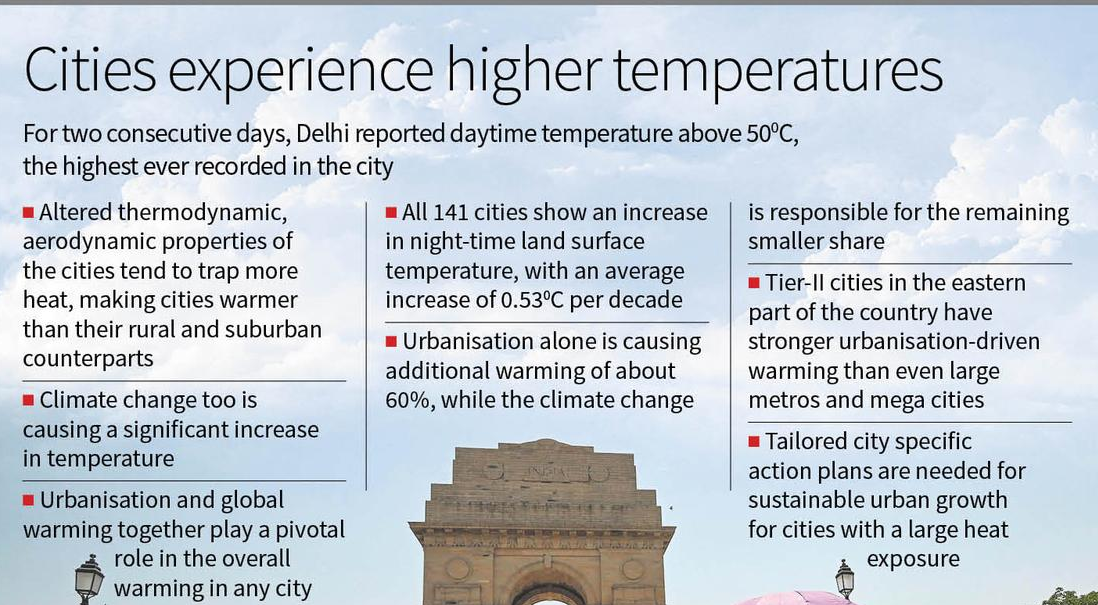Biodiversity & Environment
Rising Global Temperatures
- 03 Jun 2024
- 11 min read
For Prelims: Global warming, ocean acidification, India Meteorological Department, Greenhouse Gases (GHG), Methane, Heatwaves, Urban Heat Islands
For Mains: Environmental pollution and degradation, Rising Global Temperatures, Global warming
Why in News?
The world is witnessing a concerning trend of record-breaking temperatures across the globe, exacerbated by global warming. From the scorching 56.7°C recorded in Death Valley, California over a century ago to the recent 52.9°C reading in Delhi, temperature extremes are becoming more prevalent as the planet continues to heat up.
- If the 52.9°C recorded at a station in Delhi is verified, it would be an all-time high for India.
Note:
- The Mungeshpur weather station in Delhi recorded a record high temperature of 52.9°C, the highest ever in India. However, the India Meteorological Department (IMD) later clarified that the extreme temperature was due to an error in the sensor or local factors.
What is the Historical Context of Global Temperature Records?
- Historical High: The highest temperature ever recorded on Earth was 56.7°C in Death Valley, California, in 1913.
- United Kingdom: Surpassed 40°C for the first time in July 2022.
- China: Recorded its highest temperature of 52°C in a northwestern town last year.
- Europe: Sicily, Italy, reached 48.8°C in 2021, a record for the continent.
- India: Rajasthan's Phalodi recorded the highest temperature of 51°C in 2016.
- Global Trends: An analysis shows nearly 40% of the Earth experienced its highest-ever daily temperature between 2013 and 2023.
- This includes diverse regions, from Antarctica to various parts of Asia, Europe, and the Americas.
- Global average temperatures are currently about 1.61°C higher than pre-industrial levels.
How Global Warming is Exacerbating Global Temperatures?
- Definition: Global warming refers to the long-term increase in Earth's average surface temperature due to human activities, primarily the emission of greenhouse gases (GHG) like carbon dioxide (CO2) and methane (CH4).
- Greenhouse Gases and Temperatures: GHGs trap heat in the Earth's atmosphere, preventing it from escaping into space.
- Increased concentrations of these gasses enhance this effect, leading to more heat being retained and higher global temperatures.
- Global Temperature Rise: The planet's average surface temperature has risen about 1°C since the late 19th century, a change driven largely by increased GHG emissions into the atmosphere and other human activities.
- The past decade has seen many of the warmest years on record, with 2023 and 2024 showing unprecedented temperature increases.
- The period from May 2023 to April 2024 was the warmest 12-month period, with global temperatures about 1.61°C above pre-industrial levels.
- India Compare to Global Warming Trends: India's warming is less than the global average.
- Indian temperatures have increased by 0.7 degrees Celsius since 1900, while global land temperatures have risen by 1.59°C. When including oceans, global temperatures are now at least 1.1°C higher than pre-industrial levels.
- Global Warming and Heatwaves: Global warming is causing an increase in global temperatures and the frequency of heatwaves.
- In India Heat waves typically occur from March to June, and in some rare cases, even extend till July. On an average, five-six heat wave events occur every year over the northern parts of the country.
- Heatwaves in India are becoming more severe, with heatwave conditions even in February, a winter month for which heatwave thresholds are not defined.
- The current high temperatures in Delhi and North India seem abnormal compared to the average temperatures from 1981-2010.
- In the future, temperatures of 45°C and above may become the new normal, and a reading of 50°C will no longer be seen as unusual.
- Geographical Variability: Global warming is not causing a uniform rise in temperatures everywhere. Some regions experience faster warming due to factors like:
- Polar Amplification: The Arctic and other polar areas are warming much faster due to melting sea ice and permafrost.
- Land vs Water: Land warms faster than oceans, so continental interiors warm faster than coastal regions.
- Elevation: Higher elevations experience slower warming as the atmosphere traps less heat.
- Ocean Currents: Regions influenced by warm currents like the Gulf Stream warm faster.
- Landlocked Countries: Landlocked areas have less evaporative cooling and the continental effect, leading to more extreme temperature swings.
- Urban Heat Islands (UHIs): UHIs are metropolitan areas significantly warmer than surrounding regions due to heat-absorbing surfaces and energy use.
- As global temperatures rise, UHI intensity is expected to increase, amplifying heatwaves in cities.
- The higher urban temperatures also drive greater fossil fuel-powered cooling, further contributing to GHG emissions and warming.
- Populations in UHIs are especially vulnerable to the health risks posed by the compounded effects of UHIs and climate change.
What are the Consequences of Rising Global Temperatures?
- Sea Level Rise: As temperatures rise, glaciers and ice sheets melt, adding water to the oceans and causing sea levels to rise. This inundates coastal areas, displaces communities, and disrupts ecosystems.
- Global sea level has risen by about 8 inches since 1880 and is projected to rise by at least another foot by 2100. In a high-emissions scenario, it could potentially rise as high as 6.6 feet.
- Ocean Acidification: The oceans absorb a significant amount of the CO2 released into the atmosphere. This makes the oceans more acidic, harming marine life and disrupting ocean ecosystems crucial for the health of the planet.
- Hurricanes are expected to become stronger and more intense as the climate warms, leading to increased storm intensity and rainfall rates.
- Droughts and Heat Waves: Droughts and heat waves are expected to become more intense, while cold waves are expected to become less intense and less frequent.
- Wildfire Season: Wildfire season has been prolonged and intensified due to warming temperatures and long-term drought, increasing the risk of fires.
- Human-caused climate change has already doubled the area of forest burned and is projected to further increase the amount of land consumed by wildfires in Western states by around 2050.
- Biodiversity Loss: Rising temperatures and changing weather patterns disrupt ecosystems and habitats, pushing many plant and animal species towards extinction.
- Climate change: Extreme weather disrupts food production, leading to shortages and price hikes that harm vulnerable populations.
- Rising temperatures worsen air quality, increase heat-related illnesses, and facilitate disease spread.
- The economic consequences are severe, with high costs for repairing infrastructure, declining agricultural yields, and escalating disaster relief.
Way Forward
- Six-Sector Solution: Follow the United Nations Environment Programme’s roadmap, which includes reducing emissions across sectors like energy, industry, agriculture, forests, transport, and buildings.
- Carbon Offsetting: Invest in projects that draw down carbon from the atmosphere, such as reforestation or carbon capture and storage.
- Reduction in Greenhouse Gas Emissions: Transition to renewable energy sources like Solar, wind, geothermal, and hydro power can significantly reduce our dependence on fossil fuels.
- Implementing energy-efficient practices in homes, industries, and transportation can drastically cut down on energy consumption.
- Sustainable Agriculture: Adopt climate-smart agricultural practices, such as sustainable irrigation techniques, drought-resistant crop varieties, and agroforestry.
- Enhance food storage and distribution systems to minimise losses and ensure access to food during extreme weather events.
- Reducing deforestation, utilising regenerative agriculture techniques, and promoting plant-based diets can all contribute.
- Support Climate-Vulnerable Populations: Assist communities most vulnerable to climate change impacts, such as those in low-lying coastal areas and developing countries.
|
Drishti Mains Question: Q. Evaluate the role of global warming in exacerbating heatwaves and its impact on urban heat islands. How can urban planning mitigate these effects? |
UPSC Civil Services Examination, Previous Year Questions (PYQs)
Prelims
Q1. Which of the following statements is/are correct about the deposits of ‘methane hydrate’? (2019)
- Global warming might trigger the release of methane gas from these deposits.
- Large deposits of ‘methane hydrate’ are found in Arctic Tundra and under the sea floor.
- Methane in atmosphere oxidizes to carbon dioxide after a decade or two.
Select the correct answer using the code given below.
(a) 1 and 2 only
(b) 2 and 3 only
(c) 1 and 3 only
(d) 1, 2 and 3
Ans: (d)
Mains:
Q. ‘Climate change’ is a global problem. How India will be affected by climate change? How Himalayan and coastal states of India will be affected by climate change? (2017)






